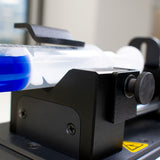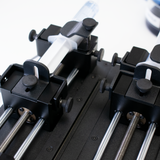Biofilm Testing Under Flow Using a Syringe Pump

Biofilms are complex microbial communities with significant implications across health, industry and the environment. Traditional static studies are unable to capture the dynamic nature found in vivo. Therefore, flow-cell systems driven by syringe pumps represent a robust option for in vitro biofilm research thanks to their tight control over experimental conditions and the production of more environmentally relevant data.
What is a Biofilm?
A biofilm is a structure consisting of microorganisms, primarily bacteria, attached to a surface and protected by a self-produced extracellular matrix often referred to as a slime layer. The matrix is made up of extracellular polymeric substances (EPS) including polysaccharides and proteins. Its main function is to protect the bacterial colonies from environmental threads such as antibiotics, disinfectants, desiccation, and immune responses.
When picturing a biofilm, imagine a strawberry jam: the bacterial cells are like the seeds, and the EPS matrix is the jam surrounding them. The nutrients are able to reach the interior cells thanks to the pores within the matrix which also enable the removal of waste. Communication among cells maintains the biofilm and attracts additional microbes, reinforcing colony expansion.
The Formation of Biofilms
Biofilm formation is a cyclic process that begins when planktonic bacteria attach to a surface. Once the initial attachment is formed, by structures like pili and fimbriae, proteins called adhesins enhance it. After the bacteria are anchored, they start to proliferate, forming a microcolony and begin secreting EPS to form the slimy matrix.
Within the biofilm, bacteria use quorum sensing - a chemical signalling system - to coordinate gene expression based on population density. This system triggers the production of the EPS matrix and other biofilm-specific traits only when a critical mass of cells is present. As the biofilm grows, the nutrients become limited, forcing parts of the colony to disperse and colonize new surfaces.
Importance of Biofilm Testing
Bacterial biofilms are widespread in both natural and engineered environments. From chronic infections and contaminated medical devices to industrial fouling and water treatment systems, biofilms play an important role in clinical, environmental, and economic challenges. Thus, there is a global need to study these microbial communities.
Biofilm testing is essential for understanding biofilm formation, growth dynamics, and resistance to antimicrobial treatments. Typically, the process incudes cultivating biofilms under controlled laboratory conditions, followed by quantitative and qualitative assessment using methods such as crystal violet staining, confocal microscopy, or viable cell counting. Detailed biofilm testing also examines factors like surface material, nutrient availability, and environmental conditions that influence biofilm development. By providing precise measurements and visualizations of biofilm structure and activity, this testing enables researchers and industries to develop effective strategies for biofilm management, control, and prevention in medical, industrial, and environmental applications.
Why Test Biofilms Under Flow?
Most traditional biofilm studies are performed in static cultures (without agitation or flow), which do not properly reflect the dynamic environments where biofilms form naturally. One of the most effective methods for studying biofilms in the lab is the use of flow cell systems, which are in vitro setups that allow researchers to examine live, fully hydrated biofilms under controlled flow conditions over extended periods. These systems provide a dynamic and physiologically relevant environment that simulates natural settings. They are particularly useful for studying how flow influences biofilm formation, structure, function, and resistance.
When biofilms are tested under flow, syringe pumps are used to deliver sterile growth media through a network of tubes into a flow cells where bacterial suspensions are inoculated. The setup usually includes:
- A syringe pump to drive precise fluid
- A flow cell - often a microscope slide-based chamber
- Universal tool clamp
- Inlet and outlet tubing for fresh media and waste
- A microscope stage for real-time imaging of biofilm development
After inoculation, bacteria attach under static conditions. Once attached, the nutrients are supplied by continuous flow to mimic shear forces encountered in vivo. Via these setups, researchers are able to control variables such as flow rate, medium composition, and incubation temperature, enabling detailed and reproducible experiments.
Workflow for Biofilm Testing
- System Preparation
- Sterilize the flow cell, tubing and syringes.
- Assemble the flow system ensuring airtight connections to prevent leaks.
- Medium Loading
- Fill the syringe with growth medium.
- Prime the tubing to remove air bubbles, as these can disrupt biofilm formation.
- Inoculation
- Introduce the microbial culture into the flow chamber.
- Allow static attachment for 30-60 minutes to enable initial adhesion.
- Flow Initiation
- Start the syringe pump at the desired flow rate.
- Flow rates mimic the shear forces relevant to your application (e.g. medical device surfaces or water pipelines).
- Monitoring Growth
- Observe biofilm development daily using microscopy.
- Optional: Collect effluent samples for biomass or metabolic activity analysis.
- Termination and Analysis
- Stop the flow after the desired growth period.
- Carefully disassemble the system for staining, imaging, or biomass quantification.
Troubleshooting Common Issues
| Problem | Possible Cause | Suggested Solution |
|---|---|---|
| Air bubbles in flow chamber | Improper priming or leaks | RE-prime tubing, check all connections, and ensure syringes are fully filled |
| Uneven biofilm growth | Inconsistent flow or uneven surface | Adjust flow rate, ensure chamber is level, and confirm culture is evenly distributed |
| Biofilm detachment | Shear stress too high | Reduce flow rate gradually; consider using a flow ramp-up protocol |
| Contamination | Non-sterile equipment or medium | Sterilize all components, use aseptic technique, and filter growth medium if necessary |
| Slow biofilm formation | Low nutrient concentration or unfavorable conditions | Adjust medium composition, temperature, or incubation time |
| Difficulty observing biofilm | Low biomass or improper staining | Use fluorescent or specific staining techniques; extend growth period if needed |
Applications of Flow-Based Biofilm Testing
Microbiology & antimicrobial research - used to study how biofilms form, resist antibiotics, and respond to environmental stressors under realistic flow conditions.
Medical device testing - simulate conditions in catheters, implants, and stents to evaluate biofilm formation and the efficacy of anti-fouling coatings.
Environmental engineering - model biofouling in pipelines or assess biofilm behavior in bioreactors for water and wastewater treatments.
Food industry - test sanitation protocols and surface contamination under realistic flow of food-grade liquids on processing equipment.
Advantages of Syringe Pumps
Syringe pumps are used for driving fluid flow in biofilm studies due to their combination of precision, flexibility, and practicality. They deliver pulseless, highly consistent flow rates, which is essential for maintaining uniform shear stress and stable nutrient delivery to the developing biofilm. Flow rates can be adjusted, ranging from picolitres to hundreds of millilitres per minute, depending on the syringe size. Syringe pumps are also programmable and can be computer-controlled to execute complex flow protocols, enhancing experimental reproducibility. Their design is highly versatile and scalable, allowing researchers to switch between microfluidic-scale setups and larger bioreactors by adjusting syringe types or using a multi-channel configurations. Many pumps support dual-mode operation, enabling both infusion and withdrawal to maintain constant media levels. In addition, syringe systems are easy to sterilize, and their disposable or autoclavable components minimize the risk of contamination. Their compact size and low vibration output make them ideal for integration with standard laboratory instruments such as microscope and incubators.
Syringe Pump

Learn More
 Automated Cell Seeding for Microfluidic Cell Culture
Automated Cell Seeding for Microfluidic Cell Culture
Microfluidic cell culture, a form of dynamic cell culture, enables researchers to simulate the complex and ever-changing environments that cells encounter in living organisms. This method is based on microfluidics, a technique that allows researchers to expose cells to the stress they experience in vivo. While the cellular environment in static cultures may become unrepresentative because of the build-up or depletion of solutes, dynamic cultures remain consistent and physiologically relevant.
Read more... The Role of Syringe Pumps in Scientific Research
The Role of Syringe Pumps in Scientific Research
Precision plays an important role in the modern research laboratory. Whether developing life-saving medications, engineering novel materials, or probing the mysteries of neuroscience, researchers are dependent on tools that ensure consistency, control, and accuracy. Among these instruments, syringe pumps are essential components of scientific research. The devices, designed to handle liquid, were specifically engineered to administer small volumes of fluids with unparalleled precision. This has made them the important aspect in accurate fluid delivery in a wide array of discipline.
Read more...